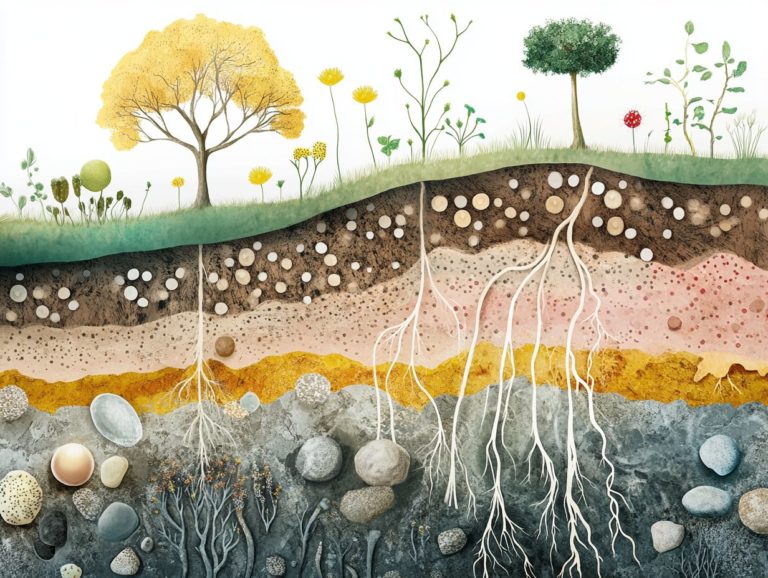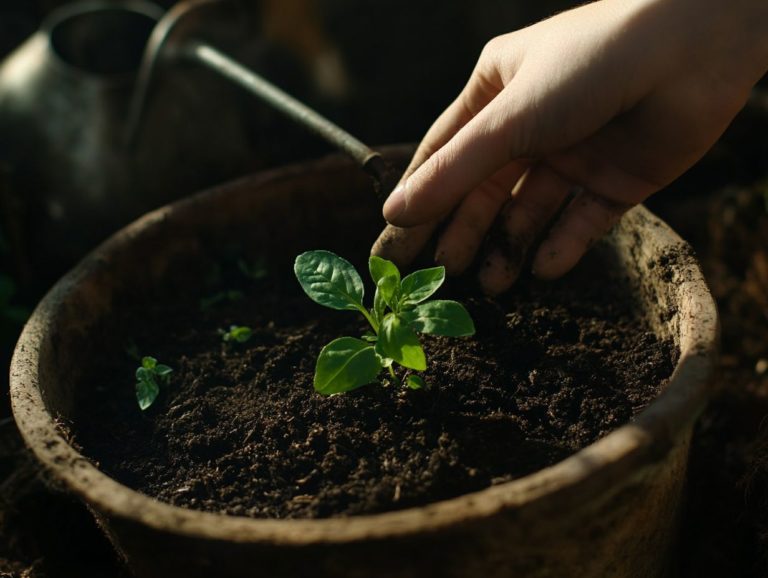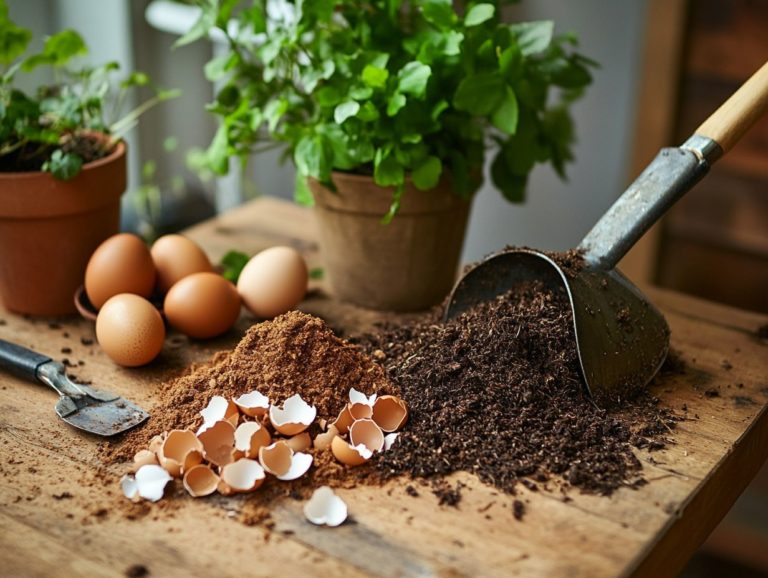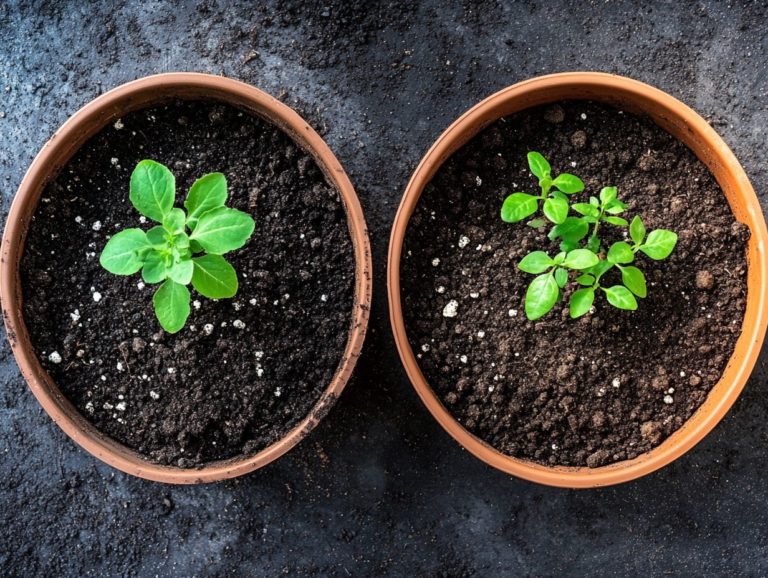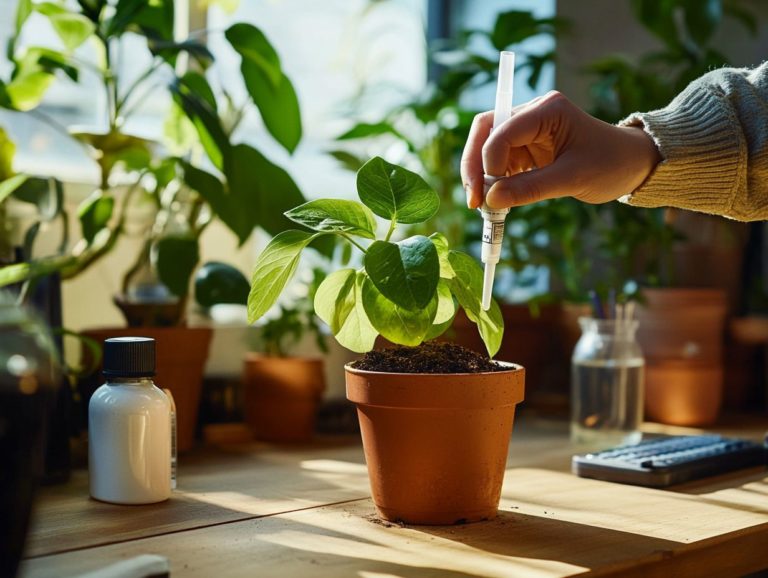Top 10 Fertilizers for Thriving Indoor Plants
Indoor plants have the power to completely transform your living space, infusing it with beauty and tranquility. However, maintaining their health and vibrancy requires some care.
One key element in plant care is fertilization, providing essential nutrients that promote robust growth and stunning blooms. This article explores the world of indoor plant fertilizers, comparing organic and synthetic options, clarifying the numbers that show how much nitrogen, phosphorus, and potassium are in the fertilizer, and guiding you in selecting the ideal fertilizer for your specific plants.
Get ready to find valuable tips on application, learn to recognize signs of nutrient imbalances, and discover the best brands to ensure your indoor garden flourishes beautifully! Don’t wait! Give your indoor garden the best chance to thrive today!
Contents
- Key Takeaways:
- 1. Organic vs. Synthetic Fertilizers
- 2. Understanding N-P-K Ratio
- 3. Slow-Release vs. Liquid Fertilizers
- 4. Choosing the Right Fertilizer for Your Type of Plant
- 5. How Often Should You Fertilize Indoor Plants?
- 6. Signs of Over-Fertilization
- 7. Signs of Under-Fertilization
- 8. Best Fertilizers for Flowering Indoor Plants
- 9. Best Fertilizers for Foliage Indoor Plants
- 10. Best Organic Fertilizers for Indoor Plants
- 11. Best Synthetic Fertilizers for Indoor Plants
- 12. Top Brands for Indoor Plant Fertilizers
- 13. How to Properly Apply Fertilizer to Indoor Plants
- 14. Common Mistakes to Avoid When Fertilizing Indoor Plants
- 15. The Importance of Properly Fertilizing Indoor Plants
- What Are the Different Types of Indoor Plant Fertilizers?
- Frequently Asked Questions
- What are the top 10 fertilizers for thriving indoor plants?
- How do I choose the right fertilizer for my indoor plants?
- What is the difference between organic and synthetic fertilizers?
- How often should I fertilize my indoor plants?
- Can I make my own fertilizer for indoor plants?
- Are there fertilizers designed for specific indoor plants?
Key Takeaways:
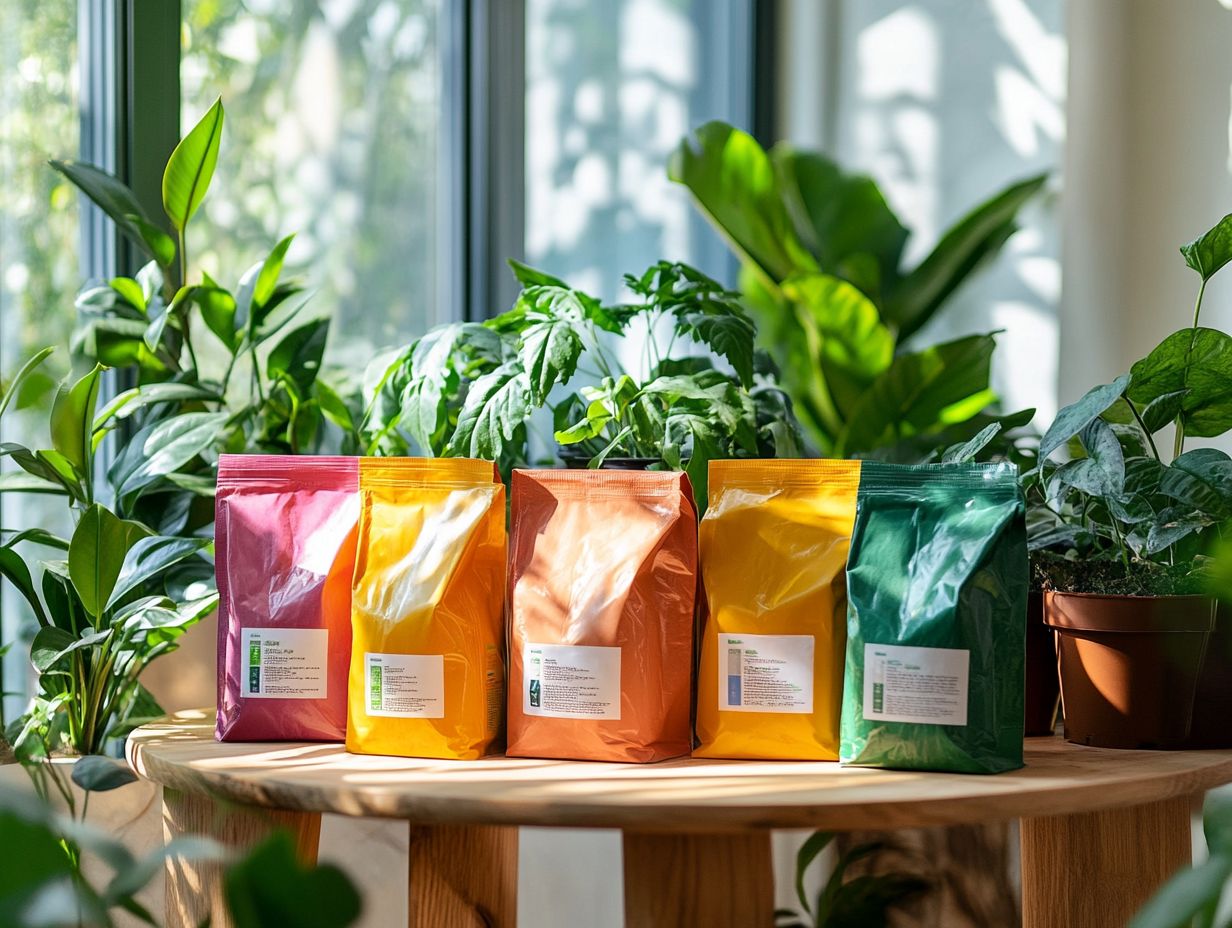
- Organic fertilizers are made from natural materials and provide a slow release of nutrients, while synthetic fertilizers are chemical-based and provide a quick burst of nutrients.
- The N-P-K ratio on fertilizer labels indicates the percentage of nitrogen, phosphorus, and potassium, respectively. This ratio helps determine the specific needs of different types of plants.
- Slow-release fertilizers release nutrients gradually over time, while liquid fertilizers provide a quick boost. The type of fertilizer you choose should depend on the needs of your plants.
1. Organic vs. Synthetic Fertilizers
When nurturing your indoor plants, grasping the difference between organic and synthetic fertilizers is essential for fostering optimal growth and overall health.
Organic fertilizers, sourced from natural materials such as decomposed plant matter, animal waste, and minerals, provide a slow and steady release of nutrients that enrich the soil over time. This approach enhances soil structure and boosts microbial activity, which is crucial for efficient nutrient uptake.
However, synthetic fertilizers are chemically formulated to deliver an immediate influx of nutrients, making them a go-to for those quick growth spurts you might need. While products like Miracle-Gro can dramatically accelerate plant growth, they come with the caveat of potential nutrient runoff the excess nutrients that can wash away from the soil, potentially harming the environment and soil degradation if used indiscriminately.
Consider these factors carefully as a plant caregiver. Some may find that the long-term benefits of organic options like Espoma outweigh the short-term gains from synthetic fertilizers, particularly when tending to delicate indoor varieties.
2. Understanding N-P-K Ratio
The N-P-K ratio is a vital concept in fertilizers, representing the relative amounts of nitrogen (N), phosphorus (P), and potassium (K) all essential for the healthy growth of your indoor plants. By grasping this ratio, you can choose the right organic fertilizer, like Dyna-Gro Grow 7-9-5 Liquid Plant Food, or a synthetic alternative, such as JR Peters Jack s Classic 10-30-20 Blossom Booster, tailored to meet your plants’ specific needs. This ensures optimal nutrient levels for your houseplants, including both flowering varieties and lush foliage.
Each nutrient plays a distinct role in plant health: nitrogen fosters lush, green leaves; phosphorus is crucial for strong root development and vibrant blooms; and potassium boosts overall vitality and stress resilience. For example, if you’re nurturing leafy vegetables like lettuce, a high-nitrogen fertilizer is your best bet. Conversely, for flowering plants such as orchids that need extra energy for their blooms, phosphorus-heavy options will serve them well.
By matching the correct N-P-K ratio to the specific requirements of your indoor plants, you not only accelerate growth but also cultivate vibrant and resilient specimens, ultimately leading to a flourishing indoor garden.
3. Slow-Release vs. Liquid Fertilizers
Understanding the difference between slow-release and liquid fertilizers is key for taking care of healthy indoor plants. Slow-release fertilizers, like Osmocote Outdoor & Indoor Smart-Release Plant Food, release nutrients gradually, making them ideal for plants in stable conditions.
On the other hand, water-soluble options like Neptune s Harvest Fish-Seaweed Blend Fertilizer provide a quick nutrient boost. They are perfect for houseplants like dracaena and pothos.
When choosing a fertilizer, consider your plants’ specific needs and their growing environment. Slow-release fertilizers work well in outdoor gardens or for perennial plants, meeting long-term nutrient needs without risking over-fertilization.
Liquid fertilizers excel when plants need quick boosts, such as transitioning seedlings or reviving stressed plants. Timing is crucial as it directly impacts your plants’ health and growth.
4. Choosing the Right Fertilizer for Your Type of Plant
Selecting the right fertilizer for your indoor plants is vital for their growth and health. Each type of plant, whether a cactus, succulent, or flowering variety, has unique nutritional requirements.
Using the right fertilizer, like Dr. Earth Organic Life All Purpose Fertilizer or JR Peters Jack s Classic, can greatly affect their development and pest resistance. Knowing these needs helps create an ideal growing environment.
Start by observing your plants growth patterns and leaf conditions. Cacti typically thrive with low-nitrogen fertilizers that boost root strength.
Succulents prefer balanced nutrients that support water storage. Flowering plants often need fertilizers rich in phosphorus to produce beautiful blooms.
By matching your fertilization strategy to each plant’s needs, you’ll enhance their vigor and appearance. Enjoy a rewarding blend of art and science in your gardening journey!
5. How Often Should You Fertilize Indoor Plants?
Figuring out how often to fertilize your indoor plants is essential for strong growth. The frequency depends on your plant type, its growth phase, and the fertilizer you select.
For most indoor plants, including flowering ones, fertilizing every 4-6 weeks during the growing season is a good rule. Adjust this based on how your plants respond.
Be attentive to signs of nutrient deficiency, like yellowing leaves or stunted growth. These may indicate that you need to tweak your fertilization approach.
Keep an eye on changes and adjust your strategy accordingly to meet your plants evolving needs. Your plants will thrive all year round!
6. Signs of Over-Fertilization
Recognizing the signs of over-fertilization is crucial for maintaining the health of your indoor plants. Too many nutrients can lead to some unfortunate outcomes. If you notice symptoms like yellowing leaves, stunted growth, or even root burn, your houseplants might be overdosing on fertilizer whether it s from organic sources like Neptune s Harvest or synthetic options.
Keeping an eye on these signs allows you to adjust your fertilization practices and create a thriving, pest-free haven for your greenery.
Over-fertilization can also lead to salt buildup in the soil. This can severely hinder water absorption and complicate your plant’s root system. This toxic environment makes it essential for you to regularly check soil moisture and nutrient levels.
If you suspect over-fertilization, flush the soil with water to dilute those excess nutrients. Afterward, reduce your fertilizer application temporarily.
By adopting a balanced fertilization schedule tailored to each plant’s specific needs, you can prevent these issues and promote robust health and growth for your indoor garden!
7. Signs of Under-Fertilization
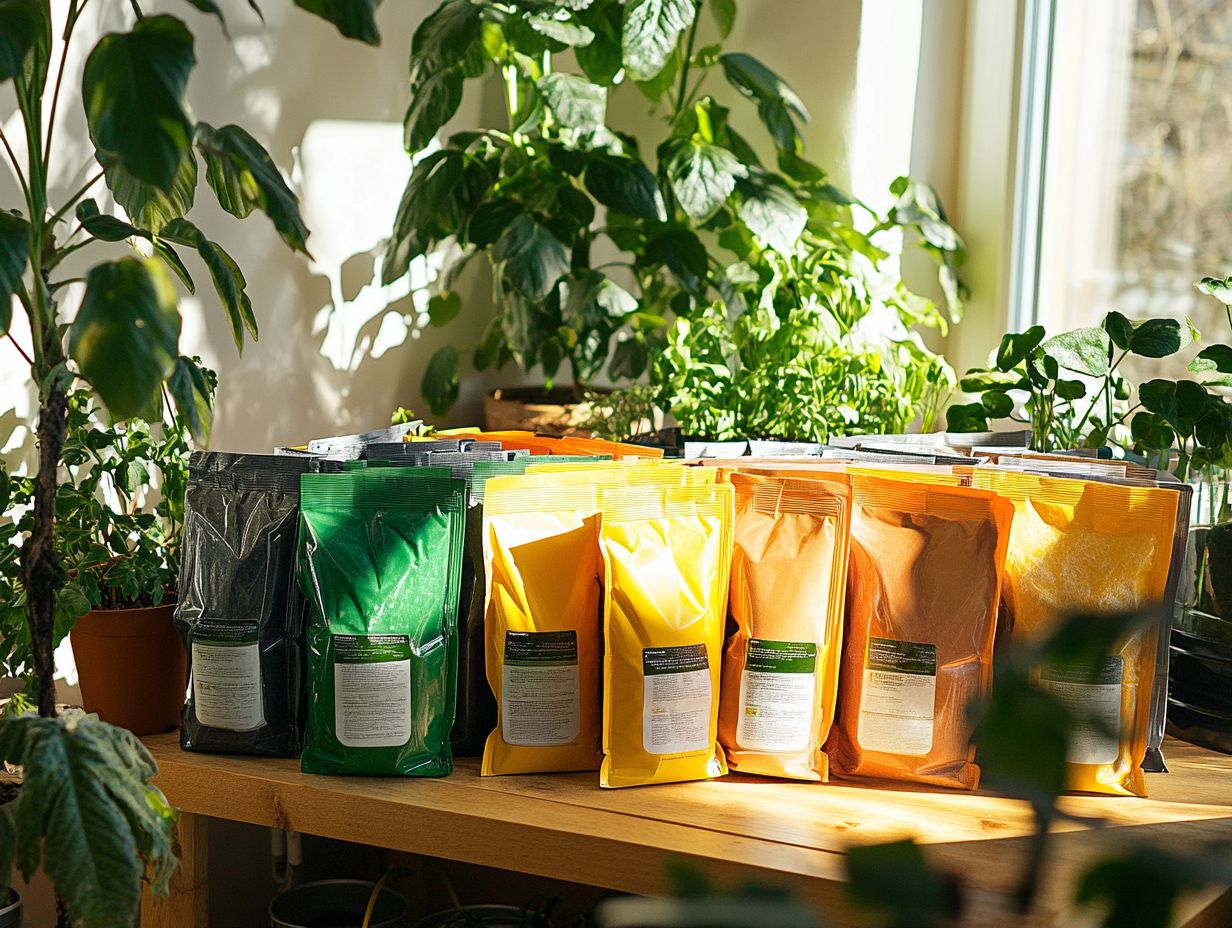
Identifying the signs of under-fertilization is essential for ensuring your indoor plants receive the nutrients they need to flourish. Look for symptoms like pale leaves, sluggish growth, and a disappointing lack of blooms; these may indicate your plants aren’t getting enough nourishment from their fertilizers, be it organic options like Dyna-Gro or water-soluble varieties.
Spotting these signs early enables you to make timely adjustments to your fertilization regimen, fostering a vibrant and healthy indoor garden.
Additionally, yellowing of older leaves and stunted root development can signal that your plant is struggling to absorb essential nutrients. Remember, different houseplants have unique nutrient requirements, and a one-size-fits-all approach simply won t cut it.
To tackle nutrient deficiencies effectively, consider conducting a soil test for insight into specific nutrient levels. You can boost growth by adding organic compost into your potting mix, creating a gradually nutrient-rich environment for sustained health and growth.
8. Best Fertilizers for Flowering Indoor Plants
Choose the right fertilizers for your flowering indoor plants to achieve stunning blooms and robust growth! Fertilizers like JR Peters Jack s Classic 10-30-20 Blossom Booster are highly effective, delivering the necessary nutrients to fuel flower production. If you prefer organic options, consider Espoma Organic Indoor Plant Food; it promotes blooms and helps maintain a healthy, pest-free environment for your indoor garden.
The fertilizer you select doesn’t just enhance the beauty of your flowers; it boosts the overall vitality and resilience of your plants against diseases.
For example, Miracle-Gro Water Soluble Bloom Booster, with its elevated phosphorus content, encourages stronger blooms while enhancing root development. If organic solutions pique your interest, fish emulsion is a fantastic choice, enriching the soil with essential nutrients and beneficial microorganisms.
Each type of fertilizer comes with unique advantages, so take the time to understand the specific needs of your flowering plants. This can lead to spectacular results and transform your indoor space into a flourishing oasis!
Start nurturing your plants today for a vibrant indoor garden!
9. Best Fertilizers for Foliage Indoor Plants
Selecting the best fertilizers for your indoor foliage plants is key to maintaining that lush, vibrant greenery you desire. Organic options, like Dr. Earth Organic Life All Purpose Fertilizer, provide essential nutrients that promote healthy leaf growth.
If you’re looking for something with a quick boost, synthetic choices such as Miracle-Gro Water Soluble All-Purpose Plant Food can deliver immediate nutrient availability. This ensures your indoor garden flourishes with beautiful, robust foliage.
Consider the specific needs of your foliage plants. Some may thrive with higher nitrogen for lush green leaves, while others might prefer a balanced or lower nutrient level to avoid leggy growth.
Understanding the growing conditions like light exposure, humidity, and the type of potting mix can significantly influence your fertilizer choice. With the right selection, you can tailor your feeding schedule to promote healthy, thriving foliage that breathes fresh air into your living space.
10. Best Organic Fertilizers for Indoor Plants
The best organic fertilizers for your indoor plants are essential for fostering healthy growth while upholding environmental sustainability. Products like Espoma Organic Indoor Plant Food and Neptune s Harvest Fish-Seaweed Blend Fertilizer not only deliver balanced nutrients but also help create a safe space for plants without pests.
By choosing these organic options, you can nurture a thriving indoor garden, whether you’re tending to cacti or vibrant flowering varieties all without resorting to synthetic additives.
Using organic fertilizers enhances the soil structure and boosts beneficial microorganisms that support lively plant life. These fertilizers release nutrients slowly, ensuring a steady supply that meets your plants’ growth needs.
By selecting such natural products, you re not just protecting your immediate environment; you re also contributing to broader ecological initiatives, as organic fertilizers typically originate from renewable sources. Improved nutrient absorption allows your indoor plants to fend off diseases more effectively, making them healthier while reducing your reliance on chemical treatments.
11. Best Synthetic Fertilizers for Indoor Plants
Selecting the right synthetic fertilizers for your indoor plants is crucial if you re aiming for quick and effective nutrient solutions. Brands like Miracle-Gro Water Soluble All-Purpose Plant Food and Dyna-Gro Grow 7-9-5 Liquid Plant Food are highly regarded for their ability to rapidly deliver optimal nutrient levels, perfectly catering to the immediate needs of your houseplants.
These fertilizers are especially valuable for busy gardeners looking for fast results, particularly during peak growing seasons. Synthetic options such as Osmocote Smart-Release Plant Food and Jack’s Classic All-Purpose Fertilizer provide extended nutrient release and specialized formulations, ensuring your plants receive consistent feeding over time.
When applying these fertilizers, it s wise to adhere to the recommended dosage to avoid over-fertilization, which can harm your plant roots. By understanding the unique nutrient requirements of your plants like the high nitrogen needs of leafy greens or the balanced nutrients favoring flowering varieties you ll know exactly what your plants need for dazzling growth!
12. Top Brands for Indoor Plant Fertilizers
In terms of indoor plant fertilizers, several top brands stand out for their quality and effectiveness in meeting the diverse needs of houseplants. Brands like Espoma Organic, Miracle-Gro, and Dyna-Gro have earned a stellar reputation for providing essential nutrients that enhance plant health and productivity. This makes them popular choices among indoor gardeners.
By familiarizing yourself with these brands and their offerings, you can make informed decisions for your indoor plant care. These brands present a variety of specialized formulations tailored to the specific needs of different plant types, including the top 10 indoor plants for artificial light, from vibrant flowering houseplants to lush leafy greens.
Espoma Organic is particularly known for its environmentally friendly options, emphasizing organic ingredients that promote not only plant vitality but also the well-being of the surrounding ecosystem. Miracle-Gro boasts an extensive selection, including both quick-release and slow-release fertilizers to suit various growth stages and watering schedules.
Dyna-Gro distinguishes itself with its concentrated, nutrient-rich products designed for rapid growth and recovery, perfect for those eager to witness swift results. The trust in these brands stems from their successful history and unwavering commitment to quality, enabling indoor gardeners to maximize their green thumbs, no matter their level of experience.
13. How to Properly Apply Fertilizer to Indoor Plants
Properly applying fertilizer to your indoor plants is crucial for ensuring they receive the necessary nutrients without the risk of over-fertilization. Start by assessing the nutrient levels in your soil and choose between organic options like Espoma Organic Indoor Plant Food or synthetic choices like Miracle-Gro.
Understanding the right application method whether through watering or direct application will help ensure that the fertilizer effectively nourishes your indoor garden. Incorporating the fertilizer into the soil enhances nutrient distribution while promoting better root absorption.
Foliar feeding, or feeding plants by spraying nutrients directly on their leaves, provides a quick boost, particularly if you notice any nutrient deficiencies. Timing matters; fertilizing during the active growth period typically yields the best results.
Over-frequent applications can lead to nutrient buildup and potential harm. Pay attention to the dosage based on the type and size of your plants to ensure each one gets the nourishment it needs without overwhelming them.
Regularly assessing the effects allows you to create a tailored feeding schedule that supports a thriving indoor plant life. Act now to ensure your plants get what they need to thrive!
14. Common Mistakes to Avoid When Fertilizing Indoor Plants
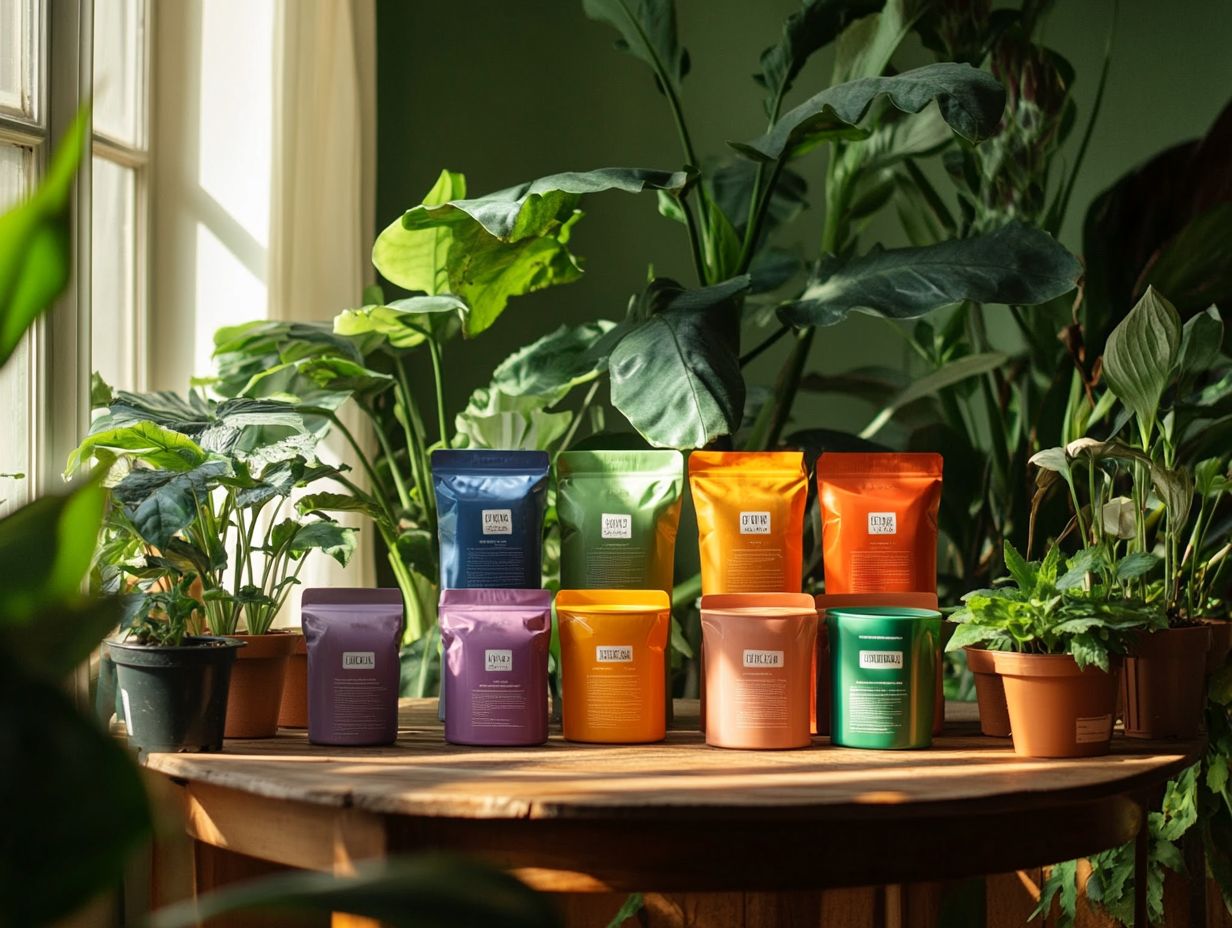
Avoiding common mistakes when fertilizing your indoor plants is essential for keeping them healthy and vibrant! It’s all too easy to accidentally over-fertilize or under-fertilize, which can throw off nutrient levels and stunt growth or even invite disease. By grasping the specific needs of your plants and timing your fertilization schedule correctly whether you prefer organic gardening methods or synthetic options you can significantly boost your indoor gardening success.
Remember, not all plants thrive under the same conditions. Factors like growth stage, light availability, and humidity play a crucial role. For example, succulents typically require far less fertilizer than their leafy tropical counterparts.
To sidestep these common pitfalls, consider conducting a soil test to identify any nutrient deficiencies. Creating a fertilization calendar that aligns with your plants’ growth cycles can ensure they receive the right nutrients at just the right times.
By regularly observing how your plants respond to fertilization, you can fine-tune your approach for even greater success in the future. Let’s dive into common mistakes!
15. The Importance of Properly Fertilizing Indoor Plants
Properly fertilizing your indoor plants is essential for achieving vibrant health, robust growth, and a pest-free environment. Ensuring that your plants receive the right nutrients at the right time directly influences their ability to thrive, produce flowers, and resist diseases.
By understanding the unique nutrient needs of your indoor plants be it cacti or flowering varieties you can cultivate an environment that promotes sustainability and longevity.
Beyond the immediate aesthetic benefits, proper fertilization contributes to healthier root systems. This enhances your plants’ ability to absorb water and nutrients efficiently. Over time, this foundation results in a visually stunning display, characterized by lush foliage and blooming flowers that elevate the ambiance of any indoor space.
When nutrients are balanced, your plants develop a stronger defense mechanism. This makes them less susceptible to common pests and pathogens. The enjoyment of your indoor greenery goes beyond mere aesthetics; it fosters a thriving ecosystem that enhances both the atmosphere and the overall well-being of your space.
What Are the Different Types of Indoor Plant Fertilizers?
Understanding the various types of indoor plant fertilizers is crucial for optimizing your plants’ health and growth. As an indoor gardener, you have several options, from organic choices like Espoma Organic Indoor Plant Food to synthetic varieties such as Miracle-Gro Water Soluble All-Purpose Plant Food.
Fertilizers can be categorized as slow-release or water-soluble. Each type is designed to meet the specific needs of your houseplants, cacti, and flowering plants.
Each type offers unique benefits that can significantly impact your plants’ vitality. Organic fertilizers enhance soil health and promote beneficial microbial activity, making them popular with the environmentally friendly gardener. In contrast, synthetic fertilizers deliver nutrients more quickly, perfect for those eager for rapid results, especially during the active growing season.
Slow-release formulations provide a steady supply of nutrients over time, ideal for busy gardeners who may not have the luxury of frequent applications. By understanding these distinctions, you can tailor your fertilizer choices to align perfectly with your plants’ growth stages and specific needs.
How Can You Tell If Your Indoor Plant Needs Fertilizer?
Knowing when your indoor plant needs fertilizer is vital. This helps keep it healthy and vibrant. Look for signs such as yellowing leaves, stunted growth, and reduced flowering. These could indicate that your houseplants need extra nutrients.
Be attentive to these signs so you can swiftly adapt your fertilization strategy. Whether you choose organic options like Dyna-Gro or water-soluble varieties such as Neptune s Harvest, it s essential to act quickly.
Regularly monitor your plants, as symptoms can worsen fast if not addressed promptly. Watch for wilting, browning leaf tips, or excessive leaf drop, as these further suggest nutrient deficiencies.
To assess your plant s overall health, check the soil moisture and ensure it s getting the right amount of light. Adjust your feeding schedules according to the plant’s growth phases like increasing during the vibrant spring and summer months to better meet its nutritional needs.
Keeping a fertilization log helps you track changes and improve your care routine.
What Are the Benefits of Using Fertilizer for Indoor Plants?
Using fertilizer for your indoor plants brings a wealth of benefits that elevate their health and appearance. Proper fertilization supports optimal nutrient levels. This results in robust growth, vibrant blooms, and strong resistance to pests and diseases.
Whether you choose organic options like Espoma Organic or synthetic alternatives such as Miracle-Gro, grasping the advantages of fertilization is crucial for your indoor gardening success.
For example, organic fertilizers often enrich the soil with beneficial microbes. This fosters a thriving ecosystem that enables your plants to absorb nutrients more efficiently. Synthetic fertilizers deliver nutrients quickly, leading to swift growth and prompt flowering.
By using a balanced fertilizer, you ensure that essential elements like nitrogen, phosphorus, and potassium are readily available, contributing significantly to your plants’ vitality. To maximize their growth potential, consider using one of the top 10 grow lights for indoor plants. Regular application of the right fertilizer helps maintain lush foliage and encourages stunning blooms, making your indoor plants healthier and more visually striking.
What Are the Environmental Effects of Using Fertilizers?
The environmental effects of using fertilizers are crucial for you as an indoor gardener aiming for sustainable practices. While fertilizers can significantly boost plant health, improper use can lead to water pollution and soil degradation.
Embracing organic gardening methods, such as using products like Neptune s Harvest, helps minimize these negative impacts while fostering a pest-free growing environment and supporting biodiversity.
Synthetic fertilizers, often loaded with nitrogen and phosphorus, can worsen issues like runoff. This contributes to excess nutrients in local waterways, creating a troublesome cycle of algal blooms that depletes oxygen and adversely affects aquatic life.
Stay alert in your fertilization methods by choosing balanced approaches that meet your plants’ immediate needs and protect the long-term health of the ecosystem. By adopting responsible practices, you cultivate healthier plants while protecting the surrounding environment. This ensures that future generations can enjoy thriving ecosystems.
How Can You Create Your Own Homemade Fertilizer for Indoor Plants?
Creating your own homemade fertilizer for indoor plants is not just a chore; it’s a rewarding endeavor. This ensures your greenery receives the nutrients it craves while championing sustainable gardening practices.
With just a few simple ingredients from your kitchen scraps, compost pile, or natural additives, you can easily make a powerful mix that supports optimal nutrient levels essential for healthy growth and vibrant foliage.
This approach helps you cultivate a flourishing indoor garden while engaging in a cost-effective, eco-friendly practice that significantly reduces waste. It emphasizes the importance of enriching soil health through natural processes, leading to a robust space that keeps pests away.
Since homemade fertilizers are typically free of harsh chemicals, they greatly enhance plant vitality over time, allowing your indoor oasis to thrive beautifully. Try making your own fertilizer today and watch your plants thrive!
Frequently Asked Questions
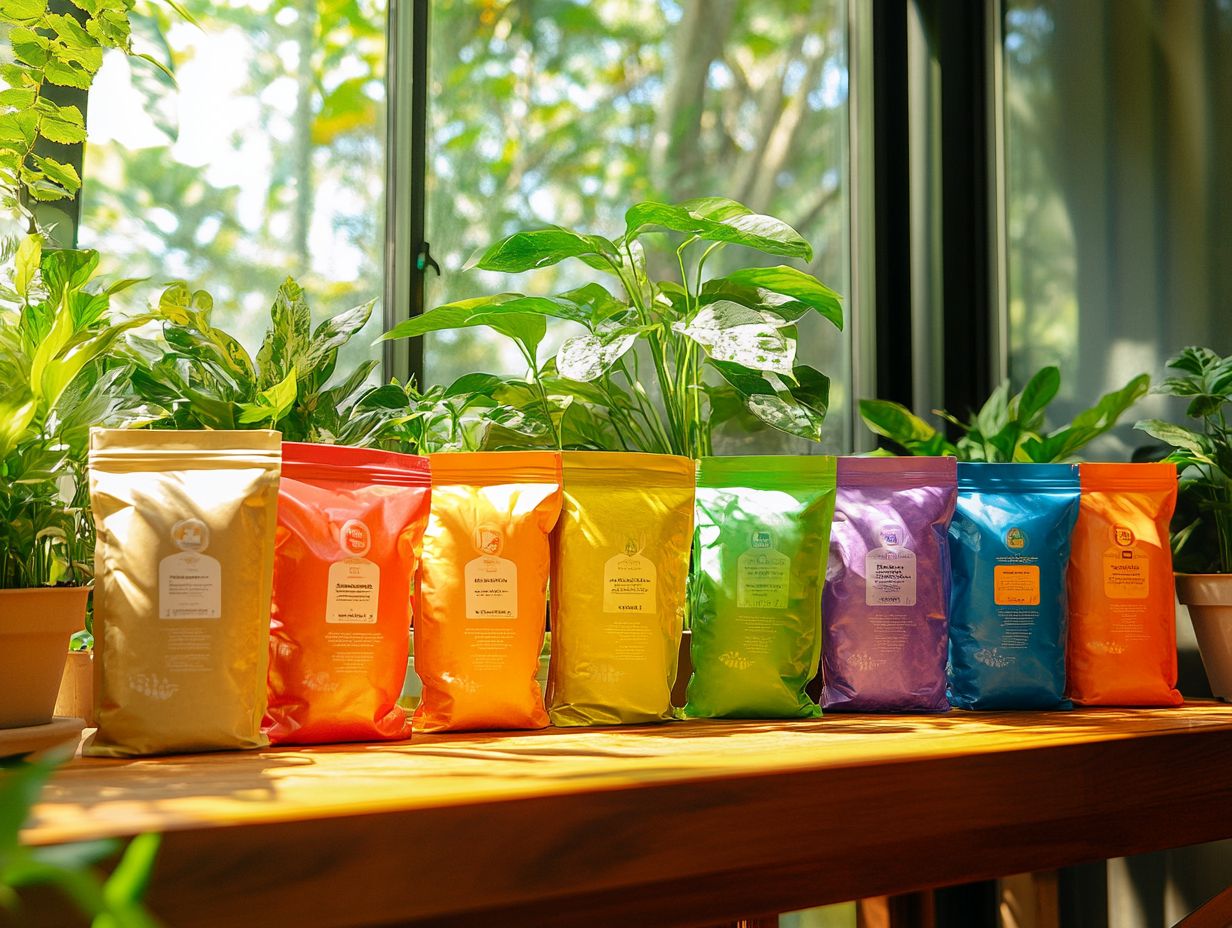
What are the top 10 fertilizers for thriving indoor plants?
The top 10 fertilizers for thriving indoor plants are liquid fertilizers, slow-release fertilizers, organic fertilizers, synthetic fertilizers, granular fertilizers, water-soluble fertilizers, all-purpose fertilizers, balanced fertilizers, nitrogen-rich fertilizers, and phosphorus-rich fertilizers.
How do I choose the right fertilizer for my indoor plants?
When choosing a fertilizer for your indoor plants, consider the type of plant, its growth stage, and its nutrient requirements. Also, think about whether you prefer an organic or synthetic fertilizer and the form liquid or granular.
If you have more questions or want to share your experiences with fertilizers, feel free to reach out!
What is the difference between organic and synthetic fertilizers?
Organic fertilizers come from natural materials like compost or manure. They release nutrients slowly and provide a balanced profile.
Synthetic fertilizers are chemically made. They deliver quick results but can burn plants if not used correctly.
How often should I fertilize my indoor plants?
Fertilization frequency depends on the fertilizer and the plant’s needs. Generally, fertilize indoor plants every 2-4 weeks during active growth.
Always follow the instructions on your fertilizer package for the best results!
Can I make my own fertilizer for indoor plants?
Yes! You can create your own fertilizer using natural ingredients like compost, coffee grounds, or eggshells.
Just be sure to research proper measurements to balance the nutrients for your plants.
Are there fertilizers designed for specific indoor plants?
Absolutely! Some fertilizers are tailored for plants like cacti, succulents, orchids, and foliage plants.
Products like Espoma Organic Indoor Plant Food and Miracle-Gro Water Soluble All-Purpose Plant Food are specially formulated to meet the unique needs of these plants. Choose wisely to promote healthy growth and flowering!


